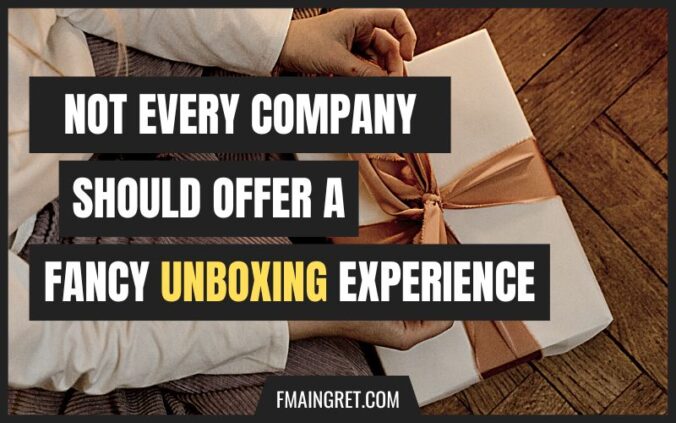If you’re anything like me, you get way too excited when you receive a notification telling you something you ordered was delivered. Unpacking and having to remove tons of tape and packing materials can kill this initial excitement. However, some companies manage to make this process exciting and provide a fun and enjoyable “unboxing experience”. You probably even came across content creators posting these “unboxing videos” and showcasing products they like. Is it worth putting so much effort into making the packaging as attractive as possible? Would every entrepreneur benefit from offering their customers this experience?
What does unboxing mean?
Let’s first define what makes a good unboxing experience according to consumers. As I explained in my previous article on free shipping, people love receiving free stuff and extra value. Nice packaging can make the actual product look even better and appear more valuable. Companies can add things like free samples of other products, coupons and discounts on future orders, or stickers (I LOVE getting free stickers, don’t ask me why). Using environmentally friendly packing materials can also be part of creating a better experience – not because it directly provides value to the customer, but because it makes the company appear more respectful. At the end of the day, financial value seems to matter the most to customers, as a study recently highlighted that customers prefer free samples and coupons. A handwritten note from the company is a nice addition and is always appreciated, but it doesn’t beat freebies.
Providing this unboxing experience is a way for companies to add something extra to their initial value proposition. Apple takes pride in its well-designed, easy-to-use products. They put tons of effort into providing product packaging that enhances this strength, making the product look beautiful in a sleek, high-quality, easy-to-open box. In the case of subscription boxes, the unboxing process is a huge part of what attracts customers and keeps them loyal. Getting people excited before they even use the product is nice, and packaging is an excellent promotional tool. Adding samples and coupons can help generate more sales and reach customers who would never consider these products without a little help. Handwritten notes and environmentally friendly materials are a good way to show that the company cares about the environment and its customer base. And, of course, all that stuff contributes to building brand equity, ensuring the brand remains in the customer’s mind as much as possible. I remember once receiving skincare products in a beautiful thick cardboard box. I kept the box and used it to store random items. Now every time I open it to get my stuff, I see the brand logo, and I remember the experience I had with their products.
A final major benefit of shipping products in these fancy boxes is that people will share their experience on social media. User-generated content can be seen as more trustworthy, and some content creators will do an amazing job promoting a brand if their experience is positive. You can easily find hundreds of examples on social media platforms.
When is providing the “unboxing experience” a good idea?
All these things sound great, right? Does that mean that every company should strive to provide the best unboxing experience they can? Not really. This decision should be based on several factors, but it all boils down to one question. Does the unboxing experience enhance the company’s value proposition, or does it diminish it?
For a brand selling premium products with a strong identity (such as Apple, as mentioned above), it makes sense to spend a little extra on nice packaging. Additionally, providing samples can greatly increase the lifetime customer value. It can really help build brand equity, especially if the brand has a strong social media presence.
Now, if the brand value proposition is based on pricing and low-cost items, it would be inappropriate to offer fancy packaging. The customer is most likely cost-sensitive, and will see the efforts as some unnecessary expense. They would rather pay less and have their stuff come in a basic corrugated cardboard box. Offering more than a basic packaging insert would diminish the brand’s efforts to be seen as a low-cost champion. Even for brands that do not compete on pricing, a disconnection between the brand identity / value proposition and the packaging used can have a negative impact. What would customers buying environmentally friendly products think if it came in a shiny box full of plastic packing materials?
Finally, providing these experiences can add a great deal of complexity to a company’s processes. The company can no longer use basic boring cardboard boxes and can only work with a limited number of suppliers. Supply chain disruptions are more likely to impact the supply of custom packing materials. Then there is the question of scaling. An Etsy seller fulfilling a few orders a week can take the time to add a handwritten thank you note to every order. It is much more authentic too, since it comes directly from the shop owner. A larger company can add one, once in a while, for some lucky or special customers. But if a random warehouse employee from Amazon wrote you a card, would you really care?
This tactic doesn’t work as well for commoditized products. Industries where products are undifferentiated, customers are cost-sensitive, and brand equity isn’t very valuable are typically industries where there isn’t much to gain from focusing on packaging.
Conclusion
In my opinion, providing a fun, enjoyable, and interesting unboxing experience can be a great asset for many brands. It can help build brand equity, generate sales, and be a promotional tool on social media. However, it should not be automatic and should always enhance the brand image and value proposition. Not every brand should do it, and some should stay away from overly sophisticated packaging.

